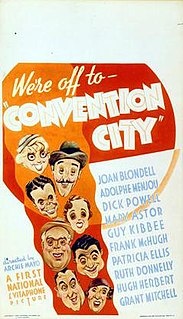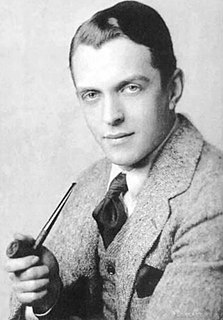Related Research Articles

Humphrey DeForest Bogart, nicknamed Bogie, was an American film and stage actor. His performances in Classical Hollywood cinema films made him an American cultural icon. In 1999, the American Film Institute selected Bogart as the greatest male star of classic American cinema.

Joan Blondell was an American actress who performed in film and television for half a century.

Kay Francis was an American stage and film actress. After a brief period on Broadway in the late 1920s, she moved to film and achieved her greatest success between 1930 and 1936, when she was the number one female star and highest-paid actress at Warner Bros. studio. She adopted her mother's maiden name (Francis) as her professional surname.

Jerome Irving Wald was an American screenwriter and a producer of films and radio programs.

Mayo Jane Methot was an American film and stage actress. She appeared in over 30 films, as well as in various Broadway productions, though she attracted significant media attention for her tempestuous marriage to actor Humphrey Bogart.

Ruth Etting was an American singer and actress of the 1920s and 1930s, who had over 60 hit recordings and worked in stage, radio, and film. Known as "America's sweetheart of song", her signature tunes were "Shine On, Harvest Moon", "Ten Cents a Dance" and "Love Me or Leave Me".

May Irene McAvoy was an American actress who worked mainly during the silent-film era. Some of her major roles are Laura Pennington in The Enchanted Cottage, Esther in Ben-Hur, and Mary Dale in The Jazz Singer.

Humphrey Bogart (1899–1957) was an American actor and producer whose 36-year career began with live stage productions in New York in 1920. He had been born into an affluent family in New York's Upper West Side, the first-born child and only son of illustrator Maud Humphrey and physician Belmont Deforest Bogart. The family eventually came to include his sisters Patricia and Catherine. His parents believed he would excel academically, possibly matriculate at Yale University and become a surgeon. They enrolled him in the private schools of Delancey, Trinity, and Phillips Academy, but Bogart was not inclined as a scholar and never completed his studies at Phillips, joining the United States Navy in 1918.

Three on a Match is a 1932 American pre-Code crime drama released by Warner Bros. The film was directed by Mervyn LeRoy and stars Joan Blondell, Warren William, Ann Dvorak and Bette Davis. The film also features Lyle Talbot, Humphrey Bogart, Allen Jenkins and Edward Arnold.

Convention City is a 1933 American pre-Code sex comedy film directed by Archie Mayo, and starring Joan Blondell, Guy Kibbee, Dick Powell, Mary Astor and Adolphe Menjou. The film was produced by Henry Blanke and First National Pictures and distributed by Warner Bros.

Genevieve Tobin was an American actress.

Stand-In is a 1937 American comedy film, directed by Tay Garnett and starring Leslie Howard, Joan Blondell and Humphrey Bogart. The picture was produced by the independent Walter Wanger, and released by United Artists. It is set in Hollywood and parodies many aspects of the film industry during the Classical Era.

Bullets or Ballots is a 1936 gangster film starring Edward G. Robinson, Joan Blondell, Barton MacLane, and Humphrey Bogart. Robinson plays a police detective who infiltrates a crime gang. This is the first of several films featuring both Robinson and Bogart.

Mary Philips was an American stage and film actress.

Kenneth MacKenna was an American actor and film director.

The musical short can be traced back to the earliest days of sound films.

Gloria Blondell was a stage, film, and television actress who was the younger sister of actress Joan Blondell.

Jessie Busley was an American actress and comedian who performed on stage, screen, and radio for over six decades.

New Morals for Old is a 1932 American pre-Code romance-drama film produced and distributed by MGM. It is based on the 1931 Broadway play After All, in which Humphrey Bogart had a significant role. Bogart's stage role is portrayed by David Newell in the film.
Vitaphone Varieties is a series title used for all of Warner Bros.', earliest short film "talkies" of the 1920s, initially made using the Vitaphone sound on disc process before a switch to the sound-on-film format early in the 1930s. These were the first major film studio-backed sound films, initially showcased with the 1926 synchronized scored features Don Juan and The Better 'Ole. Although independent producers like Lee de Forest's Phonofilm were successfully making sound film shorts as early as 1922, they were very limited in their distribution and their audio was generally not as loud and clear in theaters as Vitaphone's. The success of the early Vitaphone shorts, initially filmed only in New York, helped launch the sound revolution in Hollywood.
References
- ↑ Internet Movie Database
- ↑ Liebman, Roy (2003). Vitaphone Films: A Catalogue of the Features and Shorts. Jefferson, North Carolina: McFarland & Company, Inc. p. 50. ISBN 978-0786446971.